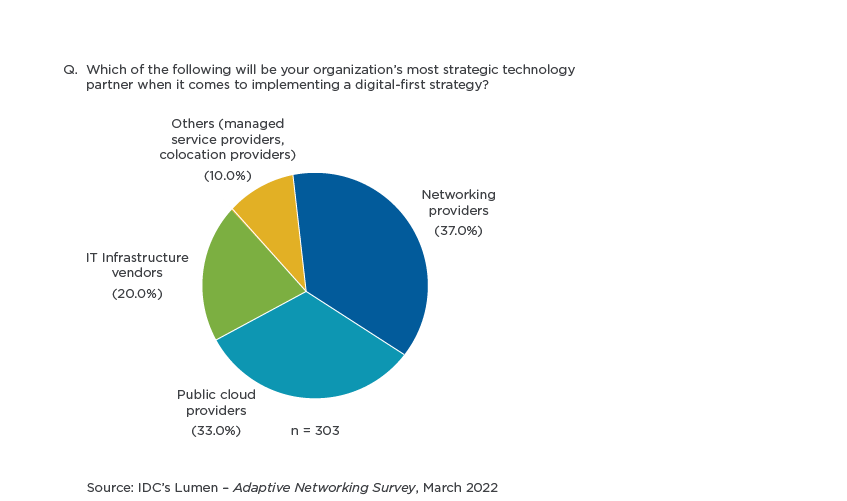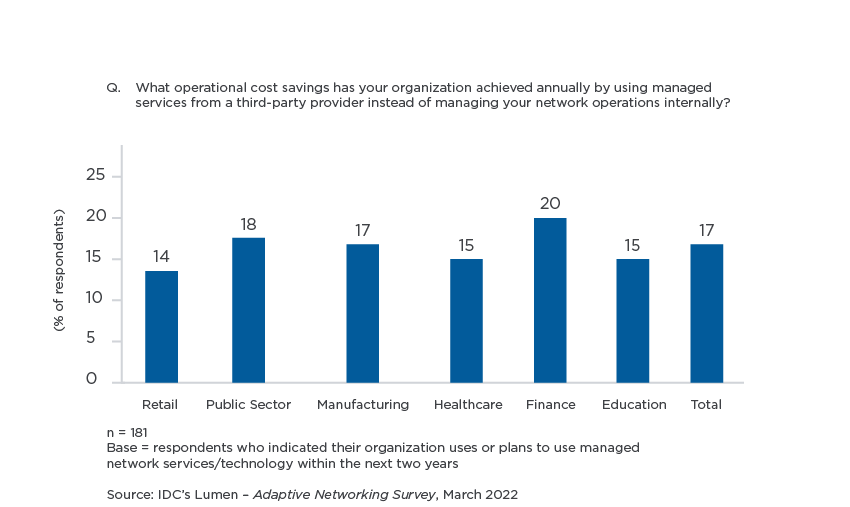Digital-First Starts With Your Network Provider

In a progressively digitized world, the benefits of having your business run digitally are tangible and compelling. But choosing physical infrastructure that’s right for your needs, migrating apps to the cloud, switching internet service providers, buying and managing software to run it all—what can you do to make it easier?
Network providers can supply a road map for the integration of edge to cloud operations, facilitating the development of low-latency use cases—with integrated security across the whole stack to keep the process safer.
Let’s take a look at how network providers can help you make a smooth and efficient change to a digital-first strategy.
What Is A Digital-First Strategy And Why You Should Care?
What does Digital-First mean?
“Digital-first” means that a business organizes and operates in a digital online environment, rather than a physical one with paper records and an in-person customer presence.
One driver behind the increasing popularity of a digital model is the move toward hybrid and work-from-home configurations. Enterprise businesses have seen this especially during the COVID-19 pandemic. Staff and skills shortages as well as inaccessible on-location operations forced businesses to accelerate the pace of digital transformation.
Transitioning to a digital approach is a complex process that involves legacy compute and storage infrastructure upgrades and app migration to the cloud. While a few large entities with robust IT departments can manage this process in-house, most businesses require an orchestrated group of partners to migrate software and infrastructure while enhancing, updating and automating processes. Of course, this must be done in a secure environment while addressing any regulatory and compliance issues.
Why is it important?
According to IDC research, 1 in 2 companies have embarked on a digital-first strategy to enhance digital resiliency.1
Enterprises have identified their top business priorities in general as improving operational efficiency (41%) and employee productivity (37%).1 Digital enterprises have significant competitive advantages in these areas over brick-and-mortar processes. They can offer engaging customer experiences through seamless interaction in both virtual and physical worlds. These benefits span sales and support from click to ship.
As more companies move forward with a digital-first strategy, existing IT departments are tasked with doing more with fewer resources. A digital-first approach provides the agility and flexibility needed to moderate risk in the face of economic shifts, supply chain issues and changing customer demand. In the process, customer engagement and experience improve, leading to favorable differentiation from competition.
Network Providers Are The Key To Strategy and Savings
Strategic Partner In The Face Of Complexity
Because digital-first adoption is an intricate process, enterprises require their IT partners to assist in establishing a digital strategy.
Network providers offer a wide range of hybrid networking options and vendor partnerships to simplify the move to digital. Broadband and fiber, SD-WAN, and both private and public cloud access services all play a role. And while we’re talking about the cloud, companies prefer the control of private cloud for managing sensitive data, but a hybrid cloud architecture offers greater flexibility and lower cost.1
Surveyed organizations said real-time visibility of network events is the first line of defense against potential security threats. Not only can network providers offer this visibility, but they are uniquely suited to deliver those insights where and when you need them. And most importantly, a proactive networking partner can simplify the task of managing geographically distributed networks.

Figure 1. Choice of Strategic Technology Partners1
In short, network providers deliver infrastructure, internet access, cloud, security and managed services all at once, as opposed to layering these solutions with several partners in a complicated, coordinated coterie.
The Top Solutions To Save Your Business Money
One of the main financial considerations in digital adoption is CAPEX (capital expenditure) versus OPEX (operational expenditure). In a do-it-yourself, CAPEX-guided model, businesses buy physical assets, such as data storage and compute devices, with a greater upfront cost and a slower ramp-up timeframe in exchange for lower long-term cost. They may also face skill-gap challenges as machines require people to run them, which in a CAPEX model, is done in-house or with pricey contractors.
By contrast, businesses with OPEX models purchase services and solutions in a network-as-a-service (NaaS) model with recurring monthly charges. Because NaaS providers already have the infrastructure and expertise behind their solutions, this model does not require a large capital investment to get a digital strategy off the ground. This results in a lower upfront cost and faster ramp-up, but greater long-term cost. OPEX models are becoming increasingly popular in the shift toward digital-first business because of the need to quickly move operations online.
Organizations report achieving 14–20% operational cost savings by using a third-party managed services provider rather than managing networks internally.1
That’s great—but how?
- SD-WAN: Reduces complexity and risks of network transformation by securing and coordinating workloads across the full range of connectivity types on a single, automated platform with centralized visibility and control.
- Edge: IoT, content management, media applications and manufacturing use cases span low-latency to ultra-low latency deployment with security, performance and operational integration.
- Fiber: IDC is projecting data consumption will grow by 25% over the next five years to 122 ZB by 2025, with most of this data consumed by enterprises.1 Companies use fiber with scalable enterprise internet bandwidth in tandem with VPNs or SD-WANs for remote work configurations.
Figure 2. Mean Operational Cost Savings Achieved by Using Third-Party Managed Services1
Expertise
Trust in your provider to get the job done right is one of the most crucial factors in making a long-term change to your operations.
Network providers are the gateway to simplified and cost-effective digital transformation because they combine the physical aspects of a network, such as cables and data storage locations, with the software and solutions to help them run at their best. Expertise in all of these areas provides businesses with a clear, tailored roadmap to network optimization in an increasingly digital world.
Another benefit is the flexibility to deploy network resources at the customer premises equipment (CPE) level, provider edge, centralized data center or cloud. These flexible deployment models can optimize OPEX and reduce overall total cost of ownership (TCO).
Network providers also offer a choice of managed service levels, giving enterprises the choice to have the managed or co-managed service option that best fits their operational needs and budget. In this way, they leverage security expertise and use managed services as a cost-effective alternative to in-house IT operations.
With all of these advantages, it’s no wonder that IT pros consider network providers as their #1 strategic technology partner.1
Why Choose Lumen As Your Network Provider
Lumen is the one-stop network provider for all your business connectivity needs. Our globally interconnected network is the backbone that makes cutting-edge SD-WAN, Edge, Fiber and SASE solutions stronger.
Lumen is backed by:
- ~340,000 global route miles of fiber
- 2,200+ connections to public and private data centers globally
- 6,300+ unique worldwide AS interconnects and the #1 peered global network2
- 50+ low-latency edge notes in key metro areas
- 30 years of network management expertise
All the services your business needs to fully digitize fall under the umbrella of Networking Solutions. Lumen solutions unleash your business potential with products that enable intelligent automation, real-time performance data and dynamic bandwidth scalability.
Many of the capabilities businesses need for digital transformation are available for purchase and configuration online through the Lumen Marketplace, enabling you to simplify and streamline processes while minimizing costs.
We can confidently say that Lumen is there for you now as you digitize your business—and we’ll be there as the world and your needs continue to change.
1IDC, Digital-First Strategy Underpins Business Resiliency, September 2022.
2The Center for Applied Internet Data Analysis, AS Rank, August 2022.
This content is provided for informational purposes only and may require additional research and substantiation by the end user. In addition, the information is provided “as is” without any warranty or condition of any kind, either express or implied. Use of this information is at the end user’s own risk. Lumen does not warrant that the information will meet the end user’s requirements or that the implementation or usage of this information will result in the desired outcome of the end user. This document represents Lumen’s products and offerings as of the date of issue. Services not available everywhere. Business customers only. Lumen may change or cancel products and services or substitute similar products and services at its sole discretion without notice. ©2023 Lumen Technologies. All Rights Reserved.
Related Posts:
- 3 Types Of Edge Computing And When To Use Them
- SD-WAN—Why The Network Matters (More)
- How To Drive Productivity By Switching To Fiber Internet
- Four Ways SASE Cuts The Cost Of IT Complexity







